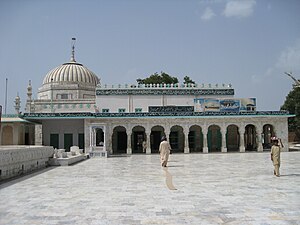| Noor Muhammad Maharvi | |
|---|---|
| نور محمد مہاروی | |
| Title | Qibla Alam |
| Personal life | |
| Born | 2 April 1730 Chhotala village, Chishtian, Sikh Empire |
| Died | 3 August 1791 Mahar Sharif, Chishtian |
| Resting place | Shrine of Noor Muhammad, Chishtian |
| Parents |
|
| Other names | Bahbal |
| Religious life | |
| Religion | Islam |
| Denomination | Sunni |
| Order | Chishti order |
| Jurisprudence | Hanafi |
| Muslim leader | |
| Predecessor | Maulana Fakhruddin |
Khawaja Noor Muhammad Maharvi (Punjabi: محمد مہاروی; born 2 April 1746, died 3 August 1793) was a Sufi saint of Chishti Order in Chishtian, Punjab, modern Pakistan.
Early life and education
Maharvi was born in 1746 at Chhotala near Bahawalnagar in the Sikh Empire in a Punjabi Muslim Rajput family of Punwar Kharal tribe. He started his early education in the small village of Mahar Sharif at the age of 4 under the supervision of Masood Mahar, located near Chishtian. He later pursued his education in Dera Ghazi Khan, Lahore, Delhi, and Pakpatan.
Noor Muhammad pledged his allegiance to Maulana Fakhruddin on February 1752 AD, which made him a member of the Fakhri branch of Chishti Order. In the same year, he arrived at Pakpattan together with Maulana Fakhruddin, which marked the end of his education. Fakhruddin then instructed Maharvi to return to Mahar Sharif and preach to the public.
Maharvi was initially given the name "Bahbal" but was later changed to "Noor Muhammad" by his teacher Maulana Fakhruddin.
Teachings
Maharvi was well-known in the region of Bahawalpur, especially after Bahawal Khan Abbasi II, ruler of Bahawalpur, became associated with him. The famous Sufi poet Ghulam Fareed also considered Noor Muhammad his spiritual guide, writing in a poem about their friendship.
Maharvi's teachings influenced conversion to Islam of many native tribes in Punjab and Sindh.
Maharvi had over 40 disciples, including Suleman Taunsvi.
Family

Noor Muhammad Maharvi had three sons (Noor us Samad, Noor Ahmad, and Noor Hassan) and two daughters.
Death

His shrine is located in Chishtian where his urs (death anniversary) is observed every year on the 1–3 day of the month Dhul al-Hijjah.
Shrine
The shrine of Maharvi was built shortly after his death. His disciple Suleman Taunsvi bought an acre of land surrounding his tomb and started the construction of the shrine. Later works were managed by his disciple Muhammad Aqil, who took responsibility for constructing the shrine's dome, and Muhammad Jamal Multani who played a major role in erecting the outer walls. Shelter for pilgrims are located on the right side of the courtyard, which was constructed by his descendants.
References
| Part of a series on Islam Sufism |
|---|
 |
| Ideas |
| Practices |
Sufi orders
|
| List of sufis |
| Topics in Sufism |
|
|
- A Glossary of the Tribes and Castes of the Punjab and North-West ..., Volume 1
- ^ Javed, Muhammad Tazeem; Shafiq, Muhammad; Ilyas, Moazam (2024-06-07). "Exploring Khawaja Noor Muhammad Maharvi's Role in Spreading Islam and Spiritual Advancement in Bahawalpur Region". Qlantic Journal of Social Sciences and Humanities. 5 (2): 212–222. doi:10.55737/qjssh.691107428. ISSN 2791-0229.
- ^ "A tribute to Khawaja Noor Maharvi". The Nation. 2012-11-01. Retrieved 2024-06-24.
- ^ Umair Mirza (2019-08-20). Maqabees Ul Majalis - Ghulam Fareed (Urdu translation).
- Jeelani, Khalid Iqbal (21 October 2022). "حضرت شاہ سلیمان تونسوی چشتی". Daily Jang.
- مولانا مفتی اقبال کھرل. Khawaja Noor Muhammad Maharvi Halat O Waqiat / خواجہ نور محمد مہاروی حالات و واقعات.